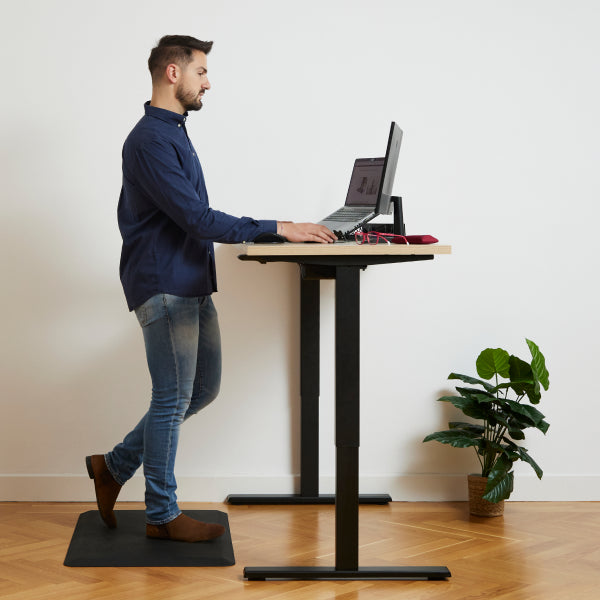Sitting for many hours is considered sedentary. Some already talk about a sedentary lifestyle as the new “smoking” of our generation, since it is something very common and apparently harmless. However, it can cause multiple health problems and up to 50% more likely to die from all causes compared to active people.
Sitting is the most comfortable position to work in as it requires minimal effort, but maintaining this position for hours and hours can be harmful to your health. Being sedentary, in addition to generating discomfort at the musculoskeletal level, also has repercussions on the cardiovascular system, renal system, at the metabolic level and even on the psychological state of people. Likewise, lack of movement reduces energy expenditure and promotes fat accumulation, which can cause overweight and obesity, insulin resistance, low-grade systemic inflammation, etc.
Health problems related to sitting
In this article we are going to break down some of the main health problems caused by spending a large part of our lives sitting , and we are going to explain how to carry out a practical solution. These are just some of the most important health problems that a sedentary lifestyle can cause:
-
Cardiovascular risk
A sedentary lifestyle causes less energy expenditure, less activation of the hormone that breaks down fats, greater accumulation of fatty tissue, an increase in circulating triglycerides (a type of fat that circulates in the blood), an increase in inflammation systemic disease, worse blood vessel function, an increase in atherosclerotic activity (the formation of plaques in the arteries), an increase in blood pressure... In short, a dangerous cocktail at the cardiovascular level.
-
Neoplasms
Movement releases natural antioxidants and anti-inflammatories, and a sedentary lifestyle causes us to lack these. In addition, it allows us to have higher insulin levels, which facilitates cell growth.
-
Chronic venous disease
The muscles in the legs play a very important role in blood circulation, since when in motion they act as a pump to push blood from the legs back to the heart. By sitting for a long time this does not occur, which decreases venous return and increases pressure in the veins of the lower extremities due to blood accumulated in them.
-
Changes in metabolism
Triglycerides increase, HDL (good cholesterol) decreases, the response to insulin decreases, the accumulation of fatty tissue increases, etc. Thus, metabolic diseases such as diabetes mellitus or metabolic syndrome can develop.
-
Kidney disorder
People who sit for more than 8 hours a day have a high risk of developing chronic kidney disease due to obesity and hypertension.
-
Alteration in posture
Sitting for long periods of time can cause problems and alterations in posture.
-
Musculoskeletal effects
Spending long periods sitting can cause a lot of pain and/or discomfort. We developed it in another blog entry “Common pains after spending long hours sitting”.
-
Psychological effects
Sitting has been shown to increase the incidence of diseases such as depression, insomnia and anxiety. Adequate physical activity may relieve symptoms or prevent future symptoms. Furthermore, sitting in front of the computer for long periods of time affects the communication that people have with others. These psychological disorders have been seen even in people who only spend 5 hours working, and we must keep in mind that a work or academic day lasts approximately 8 hours, so the risk of suffering from them is much higher.
Tips to prevent these effects
Well, we've just seen how detrimental a sedentary lifestyle can be to your health, suggesting that high levels of sedentary behavior should be avoided. However, due to our personal circumstances, it can be very difficult to lead a more active lifestyle. In this case, now we will see some tips that science gives us to reduce and prevent these very harmful effects.
Use furniture that allows you to stand and sit (such as desks that allow you to modify their height).
Improves posture, reduces musculoskeletal discomfort, improves psychosocial conditions and interaction between workers in the work environment, increases energy expenditure (up to twice as many calories are consumed when standing versus sitting), reduces levels of fatigue, decreases circulating glucose levels after meals, improves inflammation, decreases atherosclerotic activity, decreases triglycerides, improves the function of blood vessel walls, etc. In addition, standing can encourage the implementation of movement breaks, a key strategy to enhance all the positive effects mentioned.
Movement breaks
It consists of interrupting prolonged periods of inactivity with brief periods of physical activity. For example, every 30 minutes we could do a 3-minute movement break. In these breaks we could do simple strength exercises (squats, heel raises, etc.) and/or walk. Additionally, active breaks have been shown to be a good strategy to obtain greater cognitive performance without compromising task performance.
People who have sedentary lives and poor adherence to structured exercise can benefit greatly from movement breaks. In this way, regular physical activity can be integrated into daily routines.
Since the negative effects of a sedentary lifestyle have become a public health problem, information and advice for the entire population is necessary. If schools, universities and offices could adapt work spaces with lift-up desks and promote breaks in movement, the health of the general population would improve. In addition, the number of sick leave could be considerably reduced and the contentment and performance of workers and students would improve. I hope the day comes soon when applying these two simple strategies becomes normal.
BIBLIOGRAPHY:
• Soares C, Shimano SGN, Marcacine PR, Fernandes LFRM, de Castro LLPT, de Walsh IAP. Ergonomic interventions for working in a sitting position: an integrative review. Rev Bras Med Trab. 2023 Apr 18;21(1):e2023770. doi:10.47626/1679-4435-2023-770. PMID: 37197350; PMCID: PMC10185389.
• Elorza NA, Bedoya Ortiz M, Díaz Viloria JE, González Ríos MA, Martínez Rendón E, Rodríguez Echeverri M. Sitting or sitting for a long time: ergonomic risk for exposed workers. Rev CES Public Health. 2017; 8 (1): 134-147.
• Dempsey PC, Larsen RN, Sethi P, Sacre JW, Straznicky NE, Cohen ND, Cerin E, Lambert GW, Owen N, Kingwell BA, Dunstan DW. Benefits for Type 2 Diabetes of Interrupting Prolonged Sitting With Brief Bouts of Light Walking or Simple Resistance Activities. Diabetes Care. 2016 Jun;39(6):964-72. doi:10.2337/dc15-2336. Epub 2016 Apr 13. PMID: 27208318.
• Pastor-Vicedo, JC, Prieto-Ayuso, A., López Pérez, S. & Martínez-Martínez, J. (2021). Active Breaks and Cognitive Performance in Pupils: A Systematic Review. Notes Physical Education and Sports, 146, 11-23. https://doi.org/10.5672/apunts.2014- 0983.es.(2021/4).146.02
• Saunders TJ, McIsaac T, Douillette K, Gaulton N, Hunter S, Rhodes RE, Prince SA, Carson V, Chaput JP, Chastin S, Giangregorio L, Janssen I, Katzmarzyk PT, Kho ME, Poitras VJ, Powell KE, Ross R, Ross-White A, Tremblay MS, Healy GN. Sedentary behavior and health in adults: an overview of systematic reviews. Appl Physiol Nutr Metab. 2020 Oct;45(10 (Suppl. 2)):S197-S217. doi: 10.1139/apnm-2020-0272. PMID: 33054341.
• Li J, Herold F, Ludyga S, Yu Q, Zhang X, Zou L. The acute effects of physical exercise breaks on cognitive function during prolonged sitting: The first quantitative evidence. Complement Ther Clin Pract. 2022 Aug;48:101594. doi: 10.1016/j.ctcp.2022.101594. Epub 2022 Apr 20. PMID: 35483298.
• Chueh TY, Chen YC, Hung TM. Acute effect of breaking up prolonged sitting on cognition: a systematic review. BMJ Open. 2022 Mar 15;12(3):e050458. doi: 10.1136/bmjopen2021-050458. PMID: 35292487; PMCID: PMC8928248.

